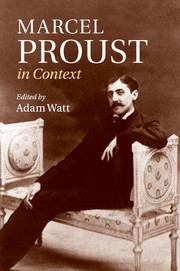Book contents
- Frontmatter
- Contents
- List of Illustrations
- Notes on contributors
- Figure I. Marcel Proust, portrait in oils by Jacques-Émile Blanche, 1892
- Preface
- Figure 2. Proust photographed on his death-bed by Man Ray, 1922
- Note on the text
- Chronology
- Part I Life and works
- Chapter 1 Life
- Chapter 2 Correspondence
- Chapter 3 Finding a form: Les Plaisirs et les jours to Contre Sainte-Beuve
- Chapter 4 Finding a voice: from Ruskin to the pastiches
- Chapter 5 Composition and publication of À la recherche du temps perdu
- Part II Historical and cultural contexts
- Part III Critical reception
- Further reading
- Index
- References
Chapter 5 - Composition and publication of À la recherche du temps perdu
from Part I - Life and works
Published online by Cambridge University Press: 05 November 2013
- Frontmatter
- Contents
- List of Illustrations
- Notes on contributors
- Figure I. Marcel Proust, portrait in oils by Jacques-Émile Blanche, 1892
- Preface
- Figure 2. Proust photographed on his death-bed by Man Ray, 1922
- Note on the text
- Chronology
- Part I Life and works
- Chapter 1 Life
- Chapter 2 Correspondence
- Chapter 3 Finding a form: Les Plaisirs et les jours to Contre Sainte-Beuve
- Chapter 4 Finding a voice: from Ruskin to the pastiches
- Chapter 5 Composition and publication of À la recherche du temps perdu
- Part II Historical and cultural contexts
- Part III Critical reception
- Further reading
- Index
- References
Summary
Proust's manuscripts and his correspondence, together with some of his contemporaries' accounts, are our sources for understanding the composition and publication of his monumental novel. Although some are missing – either destroyed by Proust himself or still in private hands – and a few are dispersed (the corrected galleys of Du côté de chez Swann, for instance, are at the Fondation Martin Bodmer), the bulk of the manuscript evidence is held in Paris at the Bibliothèque nationale de France. The Fonds Proust includes, for À la recherche alone, over 100 notebooks – four carnets and up to ninety-eight cahiers – as well as numerous corrected typescripts, galleys and proofs. Despite Proust's own scepticism relating to the ability of posterity to understand his ‘manner of working’ and the ‘evolution of [his] thought’ (Corr, xxi, 373), these manuscripts have been the object of intense scrutiny since the 1960s at least: how did Proust compose À la recherche in the years from 1908 to his death in November 1922? For the years 1909 to 1914, at least, there exists a scholarly summa that collects, critiques and completes with unprecedented scope and detail all previous research, while an international team has embarked (2008) on the exhaustive diplomatic edition of the seventy-five core cahiers of this extraordinary genesis. All ninety-eight have now been digitized, and most are already available online (gallica.bnf.fr), allowing the general public to appraise their complexity.
- Type
- Chapter
- Information
- Marcel Proust in Context , pp. 34 - 40Publisher: Cambridge University PressPrint publication year: 2013



